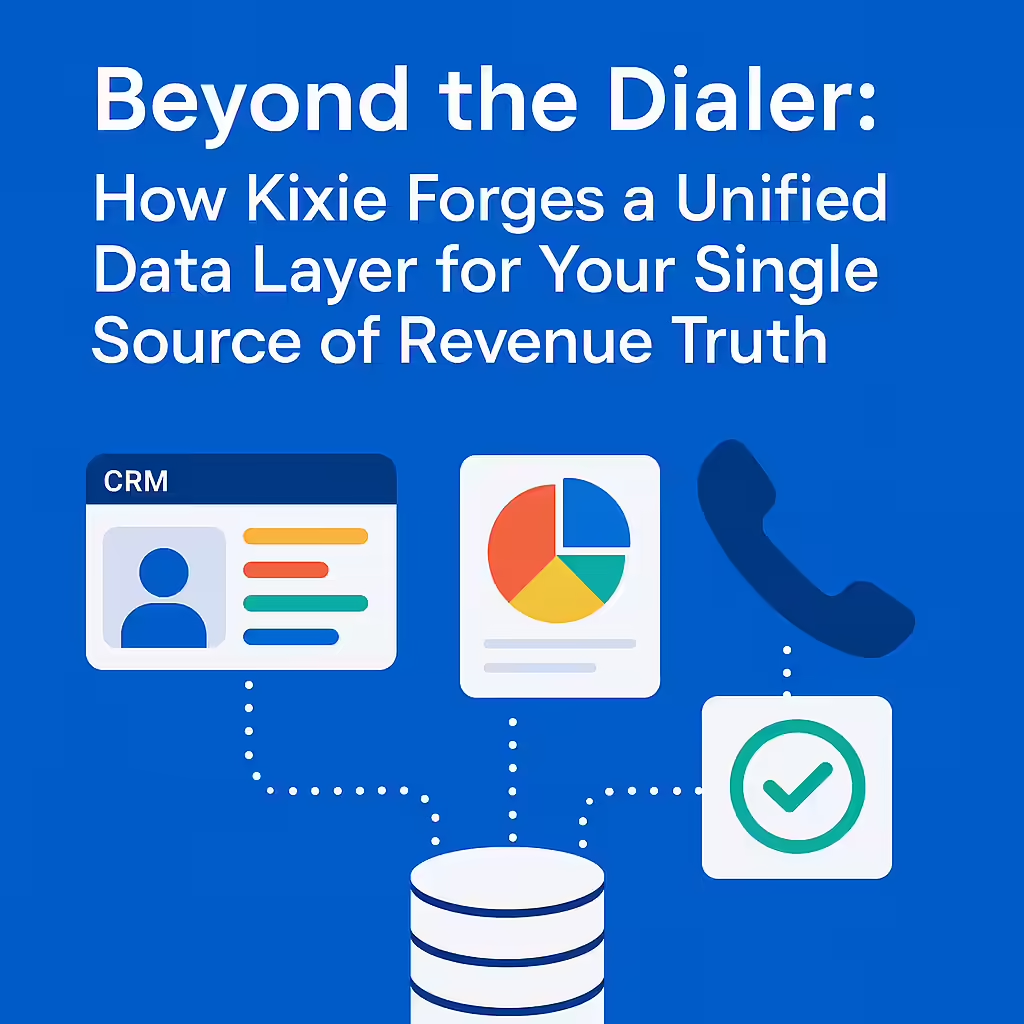The High Cost of a Disconnected Revenue Engine
Modern revenue leaders face a significant challenge, often referred to as the “tech stack paradox.” Despite unprecedented investment in tools designed to enhance efficiency, revenue teams find themselves increasingly burdened by administrative tasks. Leaders struggle to gain a clear, comprehensive view of performance due to data that is fragmented across a multitude of systems. Information is scattered across Customer Relationship Management (CRM) platforms, dialers, marketing automation software, and disconnected spreadsheets. This fragmentation creates “data silos,” forcing each department to operate as a functional black box, isolated from the others.
The antidote to this costly fragmentation is the establishment of a Single Source of Truth (SSoT). An SSoT is not a specific tool or system, but rather a state of being for an organization’s data. It is the practice of aggregating information from numerous systems into a single, centralized location. This ensures that every team—from marketing and sales to customer success and finance—operates from the same reliable, consistent, and up-to-date information. An SSoT eliminates guesswork, fosters meaningful collaboration, and empowers leaders to make strategic, data-driven decisions with confidence.
While many technology vendors claim to create an SSoT, their solutions often involve simply connecting disparate systems through complex integrations. This approach can inadvertently add layers of complexity, latency, and hidden costs without achieving true unification. A genuine SSoT requires a foundational
Unified Data Layer. This analysis will define what a Unified Data Layer is and demonstrate how Kixie, as the critical execution and feedback engine for all customer conversations, is uniquely architected to capture, harmonize, and unify the most valuable interaction data. In doing so, Kixie forms the bedrock of a reliable and actionable Single Source of Revenue Truth.
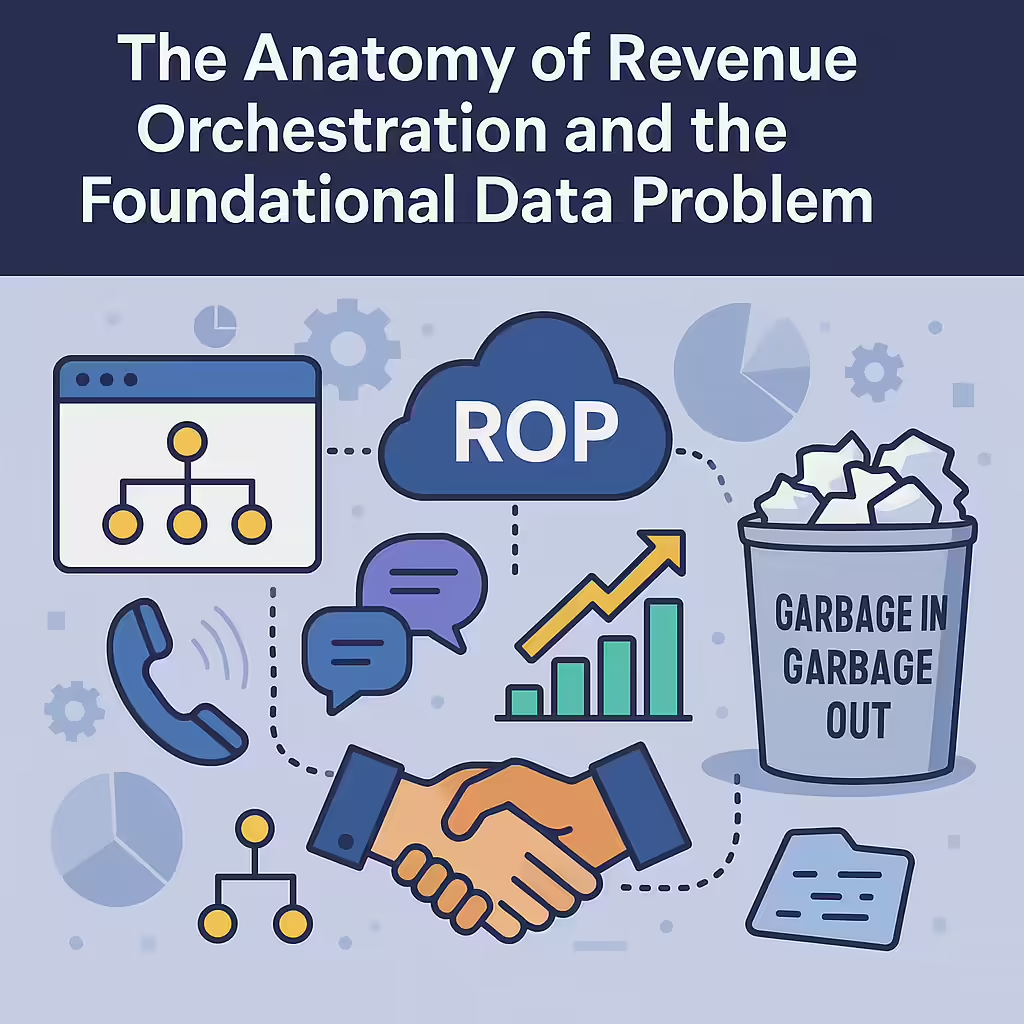
The Anatomy of Revenue Orchestration and the Foundational Data Problem
The evolution of revenue technology is a direct response to the growing inefficiencies caused by a decade of adopting disconnected, “best-of-breed” point solutions. The industry’s shift towards integrated platforms is not merely about adding more features; it is a strategic move to solve a fundamental data integration and trust gap that has hindered growth and productivity for years.
Defining the New Paradigm: The Revenue Orchestration Platform (ROP)
The industry is rapidly moving beyond siloed tools like standalone dialers or isolated conversation intelligence platforms and toward comprehensively integrated systems. This new category of technology is known as a Revenue Orchestration Platform (ROP). An ROP functions as the “central nervous system of revenue generation” for a business. It is a technology architecture that unifies once loosely connected functions—such as sasales engagementconversation intelligence, deal management, and rerevenue operationsnto a single, cohesive powerhouse. The primary objective of an ROP is to orchestrate and maximize commercial performance across the entire customer lifecycle, encompassing new logo acquisition as well as renewal and expansion motions with existing customers.
The Achilles’ Heel of Modern RevTech: “Garbage In, Garbage Out”
The immense promise of any ROP, particularly its advanced AI-powered insights and automation capabilities, is entirely contingent on the quality, completeness, and accuracy of its underlying data. The old adage “garbage in, garbage out” has never been more relevant. As David Obrand, CEO of Salesloft, notes, “If the data is not good, the likelihood is you won’t get the right insights… [and] sellers will immediately lose confidence in either the system or the leadership”. This sentiment is validated by broader industry trends; a staggering 78% of enterprises report that their AI adoption initiatives stall precisely because they do not trust their underlying revenue data. This highlights a critical, yet frequently overlooked, prerequisite for success in the modern era: a pristine, reliable data foundation.
The Tangible Consequences of Data Silos
When an organization’s data ecosystem is disconnected, the consequences are not merely theoretical. They manifest as tangible, costly problems that impact every facet of the revenue engine.
- **Inaccurate Forecasting:** Sales leaders find it nearly impossible to create reliable forecasts when critical data from different systems conflicts. This forces them to rely on intuition rather than empirical evidence, leading to missed targets and poor resource allocation.
- **Misaligned Go-to-Market (GTM) Teams:** In a siloed environment, marketing teams often generate leads and “throw them over the wall” to the sales department, never gaining visibility into how those leads progress through the funnel. Simultaneously, the sales team lacks crucial context on a lead’s prior marketing engagement, resulting in disjointed conversations and a fractured buyer journey.
- **Poor Customer Experience:** The negative impact of data silos is felt most acutely by the customer. A customer may have to repeat their needs and history to multiple departments because a support agent lacks the context from the initial sales conversation. This creates immense frustration, erodes trust, and ultimately leads to higher rates of customer churn.
- **Wasted Rep Productivity:** Sales representatives, the most expensive human resource in the revenue organization, end up spending more time on low-value administrative tasks—like manual data entry and reconciling information across different systems—than they do on their core function of engaging with prospects and customers.
This landscape reveals a crucial strategic consideration. Kixie’s advantage lies not in attempting to be the entire, all-encompassing ROP, but in perfecting the most critical and difficult-to-capture part of the data layer: live conversations. By focusing on being the premier execution and feedback layer, Kixie becomes an indispensable, future-proof component for *any* ROP stack, rather than a monolithic competitor to all of them. This allows businesses to build a more powerful, customized ROP using Kixie for communications, their preferred CRM for data unification, and a dedicated BI tool for advanced analytics, rather than being locked into a single vendor’s ecosystem. Kixie becomes the universal engine for conversation data, making the entire stack smarter.
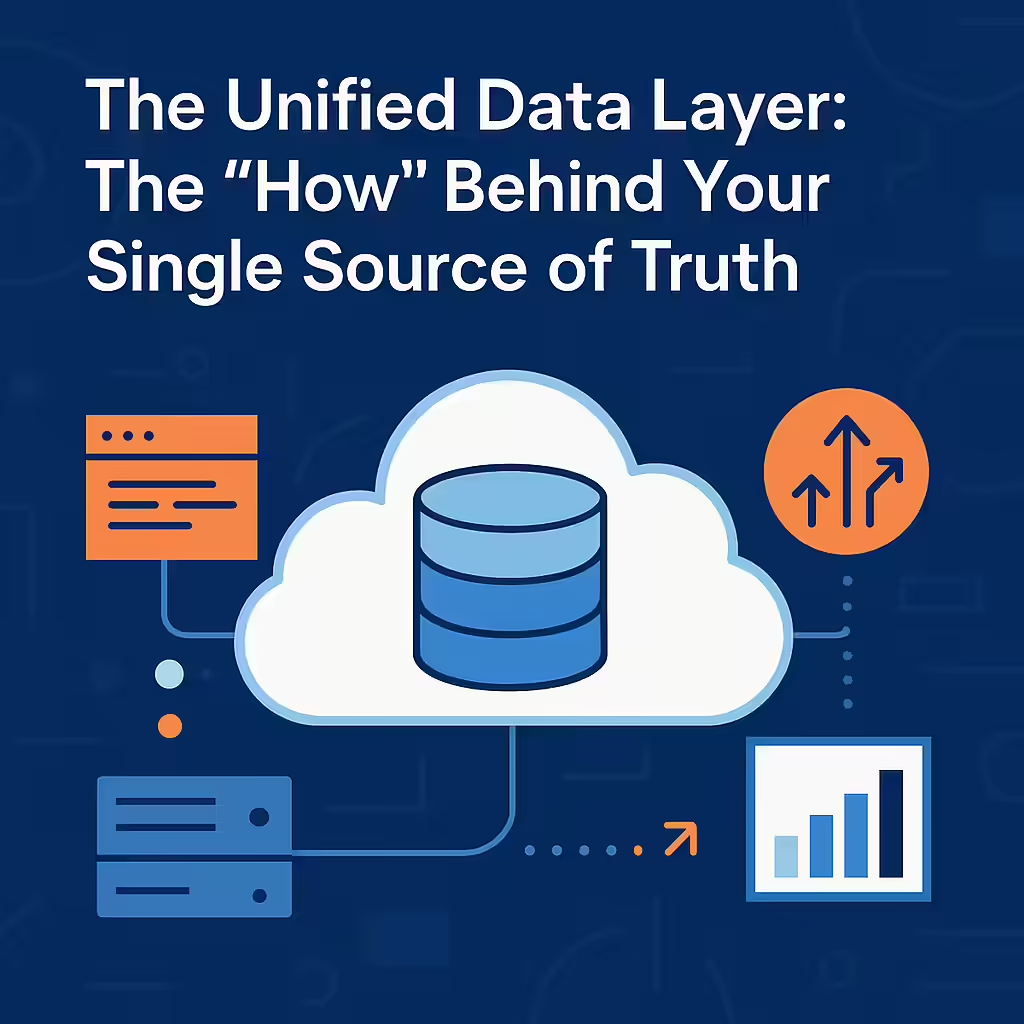
The Unified Data Layer: The “How” Behind Your Single Source of Truth
To move from the abstract concept of a Single Source of Truth to a functional reality, an organization must build the underlying technical architecture. This architecture is the Unified Data Layer. It is the “how” behind the “what”—the infrastructure that enables the business outcome of a reliable SSoT.
From Concept to Architecture: Defining the Unified Data Layer
A Unified Data Layer is a centralized, consistent data ecosystem designed to integrate information from disparate sources, thereby eliminating fragmentation and fostering cross-organizational data utilization. It creates a single, virtualized view of all relevant business data, regardless of whether that data resides in on-premise servers or in various cloud applications. This layer is responsible for ensuring that data is complete, accurate, and accessible to the systems and people who need it.
The Core Components of a Functional Data Layer
The process of transforming raw, fragmented data into actionable intelligence involves several key stages within the Unified Data Layer.
- **Centralized Collection:** The foundation of the layer is the comprehensive gathering of information from every relevant source. This includes user behavior from web and mobile tracking, operational data from backend systems, and, most critically for revenue teams, contextual information from third-party applications like Kixie. To be effective, this collection must capture every customer touchpoint across all channels to ensure data completeness.
- **Transformation and Standardization:** Raw data is inherently messy and inconsistent. The transformation layer is responsible for cleansing, validating, and mapping disparate data schemas to a standard, unified model. For instance, it ensures that a “call outcome” disposition logged by a sales rep in Kixie is formatted and defined consistently across all reports and systems, preventing ambiguity and misinterpretation.
- **Unified Storage:** This component is the central repository—often a data warehouse like Snowflake or, for many GTM teams, the CRM itself—that serves as the authoritative SSoT. By centralizing storage, this layer eliminates the need to maintain redundant, and often conflicting, copies of information across multiple systems. This reduces storage costs and minimizes data inconsistencies.
- **Activation and Delivery:** Unified data creates value only when it drives action. The activation layer is responsible for distributing this clean, standardized data back to operational systems, analytics tools, and automated workflows. This is a crucial, often overlooked, step. It ensures that the insights derived from the unified data translate directly into concrete business actions, such as triggering an automated follow-up sequence in Kixie or updating a lead score in the CRM.
The Critical Difference: True Unification vs. Simple Connection
A common point of confusion in the market is the distinction between truly unified data and merely connected data. Many platforms claim to offer “unification” when, in reality, they simply use APIs and middleware to sync information between separate, siloed systems. This is “connected data,” not “true unified data”. This connected approach often creates more problems than it solves, introducing significant complexity, data latency, and hidden maintenance costs, as the organization is still managing multiple fragmented systems at its core. True unification, which is Kixie’s architectural approach for communication data, means that information is either captured natively within a single ecosystem or is seamlessly and automatically harmonized into one, creating a frictionless flow of intelligence.
This reveals the two-way nature of an effective data layer, a concept where many tools fall short. It is not sufficient to simply collect data into a central repository. A truly orchestrated system must also be able to consume that unified data to trigger intelligent, automated actions in the frontline tools where revenue teams work. Kixie’s ability to not only feed the Unified Data Layer with rich conversational data but also to read data from the CRM to power features like Intelligent Call Routing exemplifies this advanced, closed-loop capability. This is a far more sophisticated function than simple data logging and serves as a key differentiator.
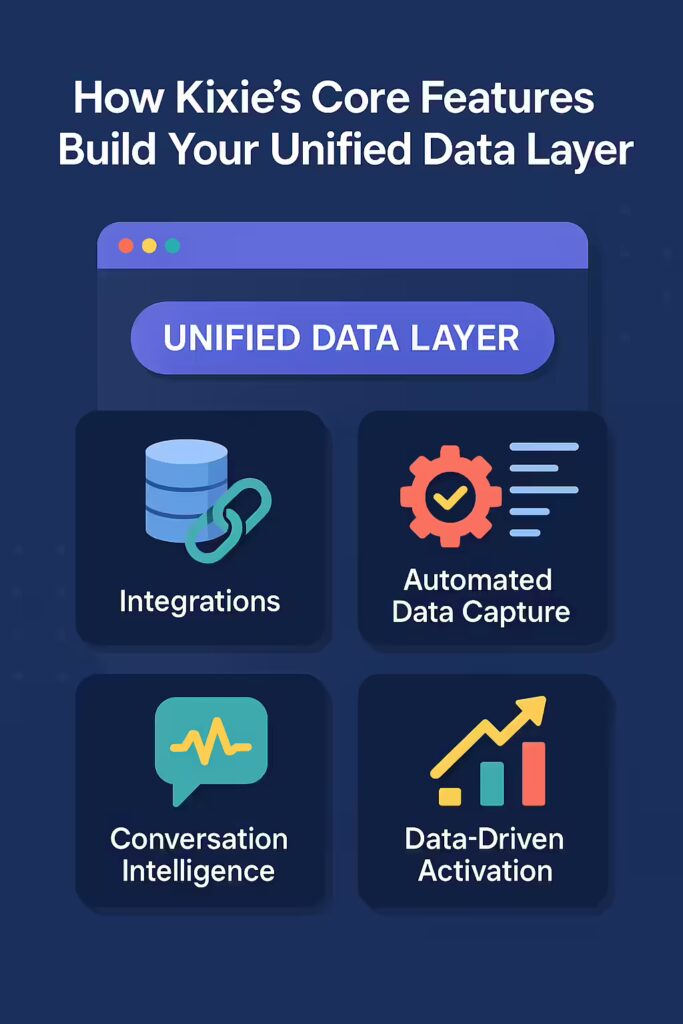
How Kixie’s Core Features Build Your Unified Data Layer
Kixie’s platform is engineered not as a collection of standalone features, but as an integrated set of components designed to build a robust, reliable Unified Data Layer for all customer interactions. Each feature plays a specific role in capturing, standardizing, and activating the conversational data that is essential for a true Single Source of Revenue Truth.
1. Integrations as the Foundation: The Data Highway
The architecture of the Unified Data Layer begins with deep, bi-directional integrations. It is not enough to simply push data in one direction; the system must support a continuous, two-way flow of information.
- **Out-of-the-Box Connectivity:** Kixie provides self-serve, native integrations with more than 25 of the industry’s leading CRMs, including HubSpot, Salesforce, Zoho, and HighLevel, as well as various helpdesks and automation platforms. This immediate, seamless connectivity is the crucial first step in breaking down the silos that traditionally exist between the communication platform and the central system of record.
- **Limitless Extensibility:** Recognizing that every revenue stack is unique, Kixie offers an open API and comprehensive webhook support. This allows Kixie to be integrated with thousands of other business tools and homegrown systems, ensuring that no part of the revenue stack is left isolated. This extensibility guarantees that Kixie can serve as the central hub for all call and SMS data, regardless of the specific CRM or other applications in use.
2. Automated Data Capture: Ensuring Completeness and Accuracy
The integrity of any SSoT is paramount, and its greatest enemy is manual data entry, which is prone to errors, omissions, and low user adoption. Kixie is designed to eliminate this vulnerability through complete automation.
- **Zero-Touch Logging:** Kixie automatically logs every inbound and outbound call, every sent and received SMS message, every call recording link, and every call disposition directly into the correct contact, deal, or account record within the CRM—all in real-time. This zero-touch process eliminates the administrative burden on reps, ensures 100% data completeness for all communication activities, and provides an accurate, time-stamped audit trail for compliance and analysis. User testimonials frequently highlight this automatic syncing as an “amazing” feature that dramatically simplifies and streamlines daily workflows.
3. Conversation Intelligence: Turning Unstructured Talk into Structured Data
A truly valuable SSoT must contain more than just activity logs; it needs to capture the *substance* of customer conversations. This is where Kixie transforms unstructured dialogue into structured, reportable data.
- **AI-Powered Transcription and Analysis:** The platform captures and transcribes every recorded call. Its proprietary AI then analyzes this raw text for sentiment (positive, negative, neutral), the usage of predefined keywords (such as competitor names or product features), and key phrases that indicate intent or risk.
- **Syncing Qualitative Insights:** Critically, these rich qualitative insights—including AI-generated call summaries, detected competitor mentions, and explicitly stated customer pain points—are automatically synced and mapped to specific fields within the CRM. This process enriches the central customer record with structured, searchable, and reportable data. It effectively transforms the CRM from a simple digital address book into a true revenue intelligence hub, providing a direct, powerful example of the data transformation and enrichment process essential to a Unified Data Layer.
4. Data-Driven Activation: Closing the Loop for Smarter Engagement
This capability demonstrates the sophisticated, bi-directional nature of Kixie’s integrations. Kixie not only writes data *to* the SSoT in the CRM but also reads data *from* it to power intelligent, real-time actions.
- **Intelligent Call Routing:** Kixie can use data stored in the CRM to make dynamic routing decisions for incoming calls. For example, the system can read the “Account Owner” field on a contact record and automatically route the incoming call directly to the assigned representative’s extension. It can also check a custom field for “VIP Status” or “Churn Risk” and send that caller to a priority queue, bypassing standard menus. This is data activation in its purest form.
- **Automated Workflow Triggers:** Kixie’s webhook-first architecture allows it to initiate powerful, automated engagement sequences based on data changes within the CRM. For instance, when a lead’s lifecycle stage is updated to “Sales Qualified Lead” in HubSpot, that event can trigger a Kixie webhook that automatically enrolls the lead into a multi-line power-dialing session. This creates a dynamic, responsive GTM motion that is orchestrated entirely by the unified flow of data.
This architecture effectively transforms the CRM into a lightweight Conversation Intelligence Platform (CIP) and a data activation hub. It democratizes access to insights that were previously locked away in expensive, standalone tools like Gong. By design, Kixie syncs its rich conversational data directly into the CRM, making it the primary SSoT, rather than hoarding that data within its own platform. This means a company using Kixie can access actionable insights natively alongside all other customer data within their existing CRM reports and workflows. Kixie’s value, therefore, extends far beyond making calls; it lies in fundamentally upgrading the CRM’s capabilities by feeding it a constant stream of structured conversational data, thereby making the entire revenue ecosystem smarter.
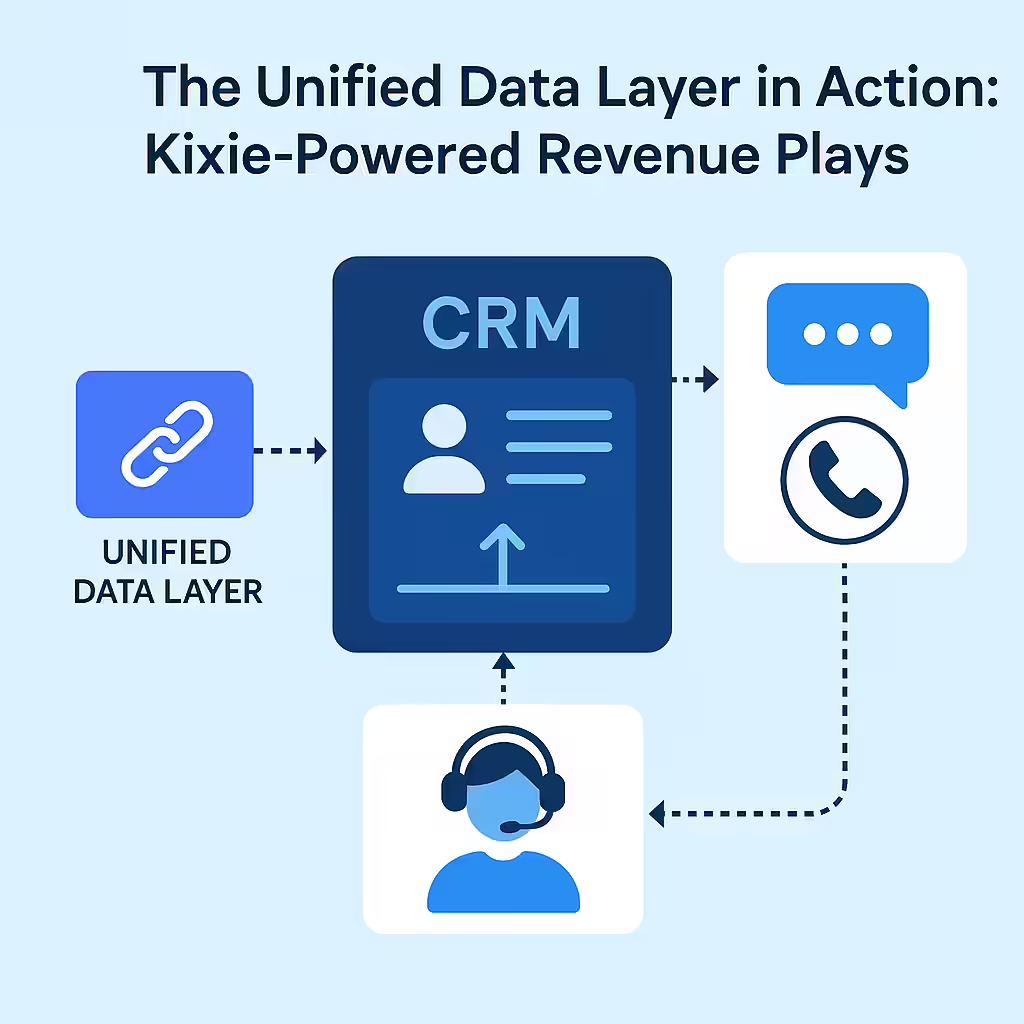
The Unified Data Layer in Action: Kixie-Powered Revenue Plays
To translate these technical capabilities into tangible business value, it is helpful to examine real-world “plays” that demonstrate the flow of data and action. Each of the following plays illustrates how a signal is captured, unified within the CRM, and then used to activate an intelligent Kixie-powered action, creating a closed-loop system of engagement and feedback.
Play 1: The “Speed-to-Lead” Inbound Play
- **Signal:** A high-intent prospect submits a “Request a Demo” form on the company website.
- **Data Unification:** The form submission data is instantly captured by the CRM (e.g., HubSpot or Salesforce), which creates a new contact record and sets its lifecycle stage to “Lead.” This becomes the initial entry in the SSoT for this prospect.
- **Kixie Activation:** This CRM update immediately triggers a Kixie webhook. Within 30 seconds, Kixie’s platform auto-dials the new lead using its AI-powered Local Presence feature, which displays a local area code to the prospect to maximize the probability of an answer.
- **Feedback Loop:** If the prospect does not answer, the sequence continues. Kixie automatically logs the “No Answer” disposition in the CRM, maintaining the integrity of the SSoT. It then triggers a pre-written, personalized SMS message (e.g., “Hey [FirstName], just tried calling about your demo request…”). Finally, it automatically schedules the contact into a multi-line power-dialer session for the assigned sales representative to attempt later that day. This entire multi-touch, multi-channel sequence is fully automated and orchestrated by the unified flow of data between the website, the CRM, and Kixie.
Play 2: The “Proactive Renewal Rescue” Play
- **Signal:** A customer’s health score, a metric tracked in a Customer Success Platform or a custom field within the CRM, dips below a predefined “High Risk” threshold.
- **Data Unification:** This critical data point is synced to the master customer record in the CRM, updating the SSoT with this new risk status.
- **Kixie Activation:** The change in the “High Risk” status triggers an automated workflow. An urgent task is created and assigned to the designated Customer Success Manager (CSM) in the CRM. Simultaneously, the customer is automatically added to a Kixie priority call queue to ensure they are contacted promptly. When the CSM initiates the call, the Kixie PowerCall dialer can display real-time sentiment cues from past interactions, pulling this data directly from the unified record in the CRM to provide immediate context.
- **Feedback Loop:** The outcome of the CSM’s call is logged in the CRM, the customer’s health score is updated based on the conversation, and the customer is automatically removed from the “at-risk” workflow, with all actions and outcomes tracked transparently within the SSoT.
Play 3: The “Competitive Intelligence” Play
- **Signal:** During a recorded sales call, a prospect mentions a key competitor, for example, stating, “We’re also evaluating a solution from SalesLoft.”
- **Data Unification:** Kixie’s Conversation Intelligence is configured to track competitor names as keywords. When the keyword is detected, the system flags the mention. The AI-generated call summary, which is automatically synced to the deal record in the CRM, includes a structured tag such as “Competitor Mentioned: SalesLoft”.
- **Kixie Activation and Feedback Loop:** This structured data point is now a permanent and reportable part of the SSoT. Revenue Operations can easily build a report or dashboard directly within the CRM to track how often each competitor is mentioned, by which reps, at what stage of the sales cycle, and on which types of deals. This transforms anecdotal field chatter into actionable, data-driven intelligence that can be used to refine sales battle cards, inform targeted coaching sessions, and guide strategic marketing adjustments.
The Business Impact: The ROI of a Single Source of Revenue Truth
Connecting technical capabilities to measurable, C-level business outcomes is essential to understanding the full value of a Unified Data Layer. The transformation from a siloed data environment to one powered by a single source of revenue truth delivers a profound and quantifiable return on investment across the entire organization. The table below provides a clear, at-a-glance summary of this transformation.
| Revenue Function | The Siloed Reality (Without Kixie) | The Unified Truth (With Kixie) |
| Data & Reporting | Fragmented data across CRM, dialer, and spreadsheets. Inaccurate, lagging reports based on incomplete, manually entered data. | All interaction data (calls, SMS, outcomes, sentiment) is auto-logged in the CRM. Real-time, unified dashboards provide a single, trusted view of performance. |
| Sales Rep Productivity | Hours spent on manual call logging and switching between apps. Reps lack context on calls, leading to repetitive conversations. | Zero manual data entry for calls/SMS. Full customer history, including conversation summaries, is available inside the CRM, saving hours per rep daily. |
| Customer Experience | Inconsistent messaging. Callers are routed to the wrong person or have to repeat information to different departments. | Seamless, personalized conversations. Intelligent Call Routing connects customers to the right agent instantly based on CRM data. Every team member has a 360-degree view. |
| Sales Coaching | Managers rely on anecdotal evidence and random call reviews. Identifying coachable moments is time-consuming and inconsistent. | AI-driven sentiment and keyword analysis surfaces key coaching opportunities at scale. Managers can review call summaries and transcriptions directly in the CRM. |
| Lead Response | Slow, manual follow-up on inbound leads. A 35-minute time-to-first-call is common, leading to massive conversion drop-off. | Automated, sub-minute call and SMS responses are triggered directly from the CRM, reducing time-to-first-call to under 9 minutes and dramatically increasing conversion rates. |
Drilling down into these outcomes reveals a clear return on investment.
- **Enhanced Decision-Making:** With a trusted SSoT, leaders can finally rely on their data. Sales forecasts become more accurate, territory planning is based on real-world activity, and high-stakes strategic decisions are grounded in holistic data rather than departmental intuition or incomplete reports.
- **Radical Team Efficiency:** By fully automating the data entry associated with calls and texts, Kixie saves individual agents hours of administrative work each day. This reclaimed time is immediately reallocated from low-value, manual tasks to the high-value activities that actually generate revenue: selling and building customer relationships. One Kixie customer reported an increase in team efficiency of over 130% after implementation.
- **Superior Customer Journey:** A Unified Data Layer ensures a seamless and intelligent customer experience. Every touchpoint is informed by the context of the last, leading to higher customer satisfaction, improved retention rates, and increased opportunities for valuable expansion and upsell revenue.
- **Predictable, Scalable Revenue Growth:** The powerful combination of better decisions, radical efficiency, and a superior customer experience creates a more effective and predictable revenue engine. Deal velocity increases, lead conversion rates improve, and revenue growth becomes a more scalable and repeatable process.
Kixie is the Engine for Your Revenue Truth
A true Single Source of Truth is not achieved by simply purchasing more software or by stitching together disparate systems with a fragile web of APIs. It is built upon a solid foundation of clean, complete, accurate, and, most importantly, unified data. Without this foundation, any investment in advanced analytics, AI, or revenue orchestration is destined to underperform.
Kixie is positioned as the indispensable Execution and Feedback Layer for any modern revenue orchestration stack. It is the engine that captures an organization’s most valuable, yet most perishable, data—the voice of the customer—and seamlessly unifies it within the central system of record. Kixie does not just help revenue teams talk to their customers; it helps their entire technology stack listen, learn, and act with intelligence. By automating the capture, standardization, and activation of all conversational data, Kixie provides the foundational Unified Data Layer required to stop wrestling with fragmented information and start building a genuine Single Source of Revenue Truth.
Ready to build your single source of revenue truth? Start a free trial of Kixie today and see how seamless data unification can transform your revenue engine.


